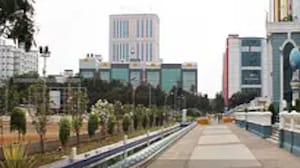IIT Madras unveils breakthrough: Water droplets capable of fragmenting natural minerals into nanoparticles
In a groundbreaking study, researchers at IIT Madras discovered that simple water droplets have the extraordinary ability to break down natural minerals into nanoparticles. This significant finding opens new avenues in nanotechnology, showcasing the potential of water in mineral fragmentation processes.

Researchers at the Indian Institute of Technology Madras (IIT Madras) have demonstrated that water microdroplets can break down common minerals to create nanoparticles, marking the first time IIT Madras research has been featured in the prestigious journal 'Science'.
Atmospheric water droplets like clouds and fog can carry charges due to ionic species and contact electrification. When minerals disintegrate on these nascent surfaces, various catalytic processes may occur, forming new molecules—potentially significant in the context of life's origins.
The team suggests that 'microdroplet showers,' made up of nanoparticles and molecules, may play a key role in Earth's chemical and biological evolution.
'Science,' the peer-reviewed journal of the American Association for the Advancement of Science (AAAS), is one of the world's most esteemed academic publications. Since its inception in 1880 with funding from Thomas Edison, it has been central to groundbreaking scientific discoveries and is highly cited globally.
This groundbreaking research was led by Padma Shri awardee Professor Thalappil Pradeep from IIT Madras' Chemistry Department, with B.K. Spoorthi, the first author who recently completed her Ph.D. at IIT Madras. Computational work was conducted by Koyendrila Debnath under the guidance of Professor Umesh V. Waghmare from the Jawaharlal Nehru Centre for Advanced Scientific Research (JNCASR), Bengaluru, and President of the Indian Academy of Sciences. The study was published in the 31st May 2024 issue of 'Science' (DOI: 10.1126/science.adl3364).
Highlighting the study's impact, Professor Thalappil Pradeep explained, "Microdroplets are known to enhance chemical reactions, and as a result, new chemical bonds form. We thought that it may be possible to break chemical bonds as well in microdroplets. That thought led to this discovery."
Discussing the applications, B.K. Spoorthi noted, "This discovery offers a revolutionary technique for soil formation, significantly speeding up natural weathering processes from centuries to moments. Beyond environmental benefits, this method advances nanotechnology and materials science, allowing for sustainable and efficient nanoparticle production with wide-ranging industrial uses."
In their experiment, the researchers found that hard minerals like river sand, ruby, and alumina, when incorporated into tiny charged water droplets, break down spontaneously to form nanoparticles within milliseconds.
These nanoparticles were collected and characterized using advanced methods. Computer simulations indicated the phenomenon may occur through 'proton-induced slip,' where atomic layers in the minerals shift, facilitated by protons. Protons and other reactive species are known to exist in tiny water droplets.
Professor Umesh V. Waghmare explained, "The phenomenon involves complex processes inherent to microdroplets of water, and understanding its mechanism will stimulate many fundamental scientific studies."
This rapid weathering process could be crucial for soil formation, given the prevalence of charged aerosols in the atmosphere. Normally, rock weathering, essential for soil formation, takes 200–400 years to produce one centimeter of soil. Nanoparticles of minerals like silica are vital for the growth of crops such as rice and wheat.
Read More
- #IIT
- # IIT madras
- # IIT 2024
- # madras
- # nanoparticles
Unlock yourpotential!
Let us know your preference and our team will guide you toward your academic journey. Stay tuned for personalized advice.
FAQ's
They found that water microdroplets can break down common minerals into nanoparticles.
It marks the first IIT Madras paper published in the prestigious 'Science' journal and offers insights into mineral disintegration and potential origins of life.
The research was led by Professor Thalappil Pradeep, with contributions from B.K. Spoorthi and Koyendrila Debnath.
It could revolutionize soil formation, accelerate natural weathering, and advance sustainable nanoparticle production.
The process involves 'proton-induced slip,' where atomic layers in minerals shift, aided by protons in charged water droplets.
Latest News

IIT Madras’ Centre for Outreach and Digital Education organises HR Summit 2024

IIT Delhi's Abu Dhabi campus announces the introduction of BTech (CSE) and Energy Engineering

IIT Madras will host a 'demo day' for JEE candidates in June

IIT Mandi to Introduce Five-Year Integrated MBA Programme for 2024-25
Photos and Videos

















COMMENTS (0)